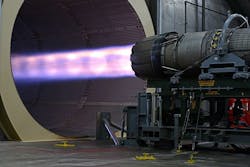Researchers eye high-temperature sensors and digital processors to enable new military capabilities
Officials of the U.S. Defense Advanced Research Projects Agency (DARPA) in Arlington, Va., issued a request for information on Tuesday (DARPA-SN-19-27) for the High-Temperature Sensing: Applications and System Impact project.
Many U.S. military and commercial systems require sensing in high-temperature environments, like the hot zones of internal-combustion and turbine engines, as well as in other related applications. Other examples are in aerospace, automotive, oil and gas, power plants, and other industries.
For military applications, however, today's commercial-grade sensors are limited in their ability to make direct measurements and extrapolating or providing cooling. All of these capabilities become more challenging as temperatures rise to 300 C, 500 C, and above 800 C.
Related: Thermal management for high-performance embedded computing
Operational temperature range, sensitivity, response, and thermal noise all can bound the usefulness of any sensor application. Commercial sensors with the necessary capabilities, moreover, can be expensive, heavy, and power-hungry.
Instead, DARPA researchers are looking for small and lightweight temperature sensors and digital processors with on-board power management, that can perform in-situ sensing, signal amplification, and conditioning.
Military systems require significant share of digital processing at locations where the temperature exceeds 200 C -- either due to external heat sources or due to self-heating of the microelectronics compounded by the lack of a local heat sink, DARPA researchers point out.
As a result, embedded computing tends to be localized and actively cooled, resulting in additional size, weight, and power consumption for cooling, and severely limiting system layout options.
Related: Air Force reaches out to industry for companies able to build advanced IR sensor processing
Developing digital microprocessing technologies capable of reliable operation in the 200 C to 300 C temperature range significantly could alleviate the needs for bulky and expensive thermal management designs, as well as open new system engineering options for digital processing distributed throughout military systems.
Researchers also are interested in the kinds of data they could gather, and the kinds of analytics they could offer, if high-temperature sensors were more broadly available.
What if researchers, for example, could map a car or truck engine's dynamic temperature, pressure, and gas flow in real time with on-board high-temperature sensors? Could it enable them to improve engine power, efficiency, and responsiveness? What health monitoring benefits could they expect in lifetime and failure rates?
DARPA researchers are asking industry for applications that sensors could enable by operating in 300 to 500 C, 500 to 800 C, and beyond 800 C.
In particular, DARPA is interested in new or existing military applications that could be improved from closed-loop control with sensors operating at high temperatures; high-temperature support electronics necessary that is not currently available; and how high-temperature sensors could make military systems more affordable.
DARPA researchers also are interested in digital microprocessing technologies able to operate reliably between 200 and 300 C, and the capabilities these high-temperature processors could yield for the warfighter.
Companies interested should email five-page responses to DARPA no later than 12 April 2019 at [email protected]. Send questions or concerns to the same email address.
More information is online at https://www.fbo.gov/spg/ODA/DARPA/CMO/DARPA-SN-19-27/listing.html.
Ready to make a purchase? Search the Military & Aerospace Electronics Buyer's Guide for companies, new products, press releases, and videos
